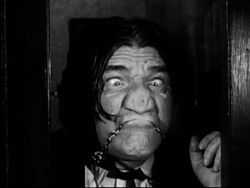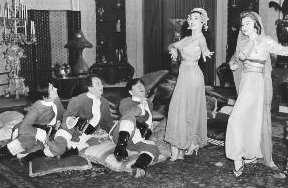Shemp Howard
| Shemp Howard | |
|---|---|
|
Shemp Howard, circa 1945 | |
| Born |
Samuel Horwitz March 11, 1895 Manhattan, New York, U.S. |
| Died |
November 22, 1955 (aged 60) Hollywood, California, U.S. |
Cause of death | Heart attack |
| Occupation | Actor/Comedian |
| Years active | 1923–1955 |
| Spouse(s) | Gertrude Frank (1925-1955) |
| Children | Morton (1926–1972) |
Shemp Howard (March 11, 1895[1] – November 22, 1955[2]) was an American actor and comedian. Born Samuel Horwitz, he was called "Shemp" because "Sam" came out that way in his mother's thick Litvak accent. He is best known today for his role as the third stooge in the Three Stooges, a role he first portrayed at the beginning of the act in the early 1920s (1923-1932) while the act was still associated with Ted Healy and known as "Ted Healy and his Stooges", and again from 1947 until his death in 1955. Between those times, Shemp had a successful film career as a solo comedian.
Early life
Shemp was born in Manhattan, New York, and raised in Brooklyn. He was the third-born of five Horwitz brothers and the son of Lithuanian Jewish parents. Moe Howard and Curly Howard were his younger brothers.
Career
Show business

Moe Howard entered show business as a youngster, on stage and in films. Eventually, he and older brother Shemp tried their hands as minstrel-show-style "blackface" comedians with an act they called "Howard and Howard—A Study In Black", and even worked for a rival vaudeville circuit at the same time by appearing without makeup. By the 1920s Moe had teamed up with boyhood-friend-turned-vaudeville star Ted Healy in a "roughhouse" act. One day Moe spotted his brother Shemp in the audience, and yelled at him from the stage. Quick-witted Shemp yelled right back, and walked onto the stage. From then on he was part of the act, usually known as "Ted Healy and His Stooges". On stage, Healy would sing and tell jokes while his three noisy stooges would get in his way. He would retaliate with physical and verbal abuse. His original stooges were the Howard brothers and Larry Fine. Shemp played a bumbling fireman in the Stooges' first film, Soup to Nuts, the only film in which he plays one of Healy's gang.
Healy was always the main attraction of the act, and his stooges were in constant disagreement with him over billing, money and management. Tired of what he considered Healy's domineering handling of the Stooges' career, Shemp left Healy's act in 1932 to pursue a solo film career and was immediately replaced by his and Moe's younger brother, Jerry (Curly).[3]
Solo years
Shemp Howard, like many New York-based performers, found work at the Vitaphone studio in Brooklyn. Originally playing bit roles in Vitaphone's Roscoe Arbuckle comedies, showing off his goofy appearance, he was entrusted with speaking roles and supporting parts almost immediately. He was featured with Vitaphone comics Jack Haley, Ben Blue and Gus Shy, then co-starred with Harry Gribbon, Daphne Pollard and Johnnie Berkes, and finally starred in his own two-reel comedies. A Gribbon-Howard short, Art Trouble (1934), also featured the then unknown James Stewart in his first film role.
Shemp would seldom stick to the script, and would liven up a scene with ad-libbed incidental dialogue or wisecracks. This became a trademark of his performances. In late 1935, Vitaphone was licensed to produce short comedies based on the "Joe Palooka" comic strip. Shemp was cast as "Knobby Walsh," and though only a supporting character became the comic focus of the series, with Johnny Berkes and Lee Weber as his foils. He costarred in the first seven shorts, released during 1936 and 1937; nine were produced altogether, with the last two done after Shemp's departure from Vitaphone for greener pastures on the West Coast.

Away from Vitaphone he attempted, unsuccessfully, to lead his own group of "stooges" in the Van Beuren musical comedy short The Knife of the Party. But Shemp's solo career was very successful otherwise. He followed his brothers' lead, moved to the West Coast in 1937 and landed supporting-actor roles at several studios, predominantly at Columbia Pictures and Universal Studios. He performed with such comic greats as W. C. Fields, with whom he played the bartender in the 1940 film The Bank Dick; and with duo-comedians Abbott and Costello, who would reportedly trim his scene-stealing material. He also lent comic relief to Charlie Chan and The Thin Man murder mysteries, and was in several Universal B-musicals of the early 1940s, among them Strictly in the Groove, How's About It?, Moonlight and Cactus and San Antonio Rose, in which he is paired with Lon Chaney, Jr. as a faux Abbott and Costello. Most of these took great advantage of his improvisational skills. He was briefly teamed with comedians Billy Gilbert and Maxie Rosenbloom for three B-comedy features in 1944–45. He also played a few serious parts, such as his supporting role in Pittsburgh (1942), starring Marlene Dietrich and John Wayne.
The Three Stooges: 1947–1955
From 1939 onwards, Shemp appeared frequently in Columbia's two-reel comedies, co-starring with Columbia regulars Andy Clyde, The Glove Slingers, El Brendel and Tom Kennedy. He was given his own starring series in 1944; he was working for Columbia in this capacity when his brother Curly was felled by a debilitating stroke on May 6, 1946. Shemp reluctantly replaced Curly in Columbia's popular Stooge shorts, knowing that Moe and Larry would be out of work if he refused. He rejoined the Stooges at first on only a temporary basis until Curly recovered, but as Curly's condition worsened it became apparent that Shemp's association with the Stooges would be permanent. (Before replacing Curly on film, Shemp had substituted for his brother in some personal appearances in the early 1940s.)
Shemp's role as the third Stooge was much different from Curly's. While he could still roll with the punches in response to Moe's slapstick abuse, he was more of a laid-back dimwit as opposed to Curly's energetic man-child persona. And unlike Curly, who had many distinct mannerisms, Shemp's most notable characteristic as a Stooge was a high-pitched "bee-bee-bee-bee-bee-bee!" sound, a sort of soft screech done by inhaling. This was rather multi-purpose, since Shemp emitted this sound when scared, sleeping (done as a form of snoring), overtly happy or dazed. Also, whenever he laughed (whether it came from reading comics or being tickled), he would sound like Moe in a more comical high-pitched voice.
Shemp appeared with Moe and Larry in 73 short subjects and the feature film Gold Raiders. He suffered a mild stroke in November 1952, although he recovered from it within weeks and without noticeable effect on his remaining films with the Stooges (largely remakes of earlier films that used recycled footage to reduce costs).
Personal life
In September 1925, Shemp (at 30) married Gertrude Frank (at 28), a fellow New Yorker. They had one child, Morton (1926–1972). Former U.S. Representative Barney Frank (D-MA) is the son of Gertrude's cousin Sam Frank.[4]
Shemp used his somewhat homely appearance for comic effect, often mugging grotesquely or allowing his hair to fall in disarray. He even played along with a publicity stunt that named him "The Ugliest Man in Hollywood". ("I'm hideous," he explained to reporters.) Notoriously phobic, his fears included airplanes, automobiles, dogs and water.
According to Moe's autobiography, Shemp was involved in a driving accident as a teenager and never obtained a driver's license.[5]
Death
On November 22, 1955, while returning home by taxicab from a boxing match (one of Shemp's favorite pastimes), he died of a heart attack. He was lighting a cigar after telling a joke when he suddenly slumped over on his friend Al Winston's lap. Al thought Shemp was acting out a joke before realizing he was actually dead. Moe's autobiography gives a death date of November 23, 1955, as do most subsequent accounts because of Moe's book. But much of that book was finished posthumously by his daughter and son-in-law, and some specific details were confused as a result. The Los Angeles county coroner death certificate states that Shemp Howard died on Tuesday, November 22, 1955 at 11:00 [PM] PST; confirming that, Shemp's obituary appeared in the November 23 afternoon editions of L.A. newspapers, establishing the night of November 22 as the date of death.[6] He was interred in an indoor crypt at the Home of Peace Cemetery in East Los Angeles, as was his brother Curly.
"Fake Shemp"

Columbia had promised exhibitors eight Three Stooges comedies for 1956, but only four had been completed at the time of Shemp's death. To fulfill the contract, producer Jules White manufactured four more shorts by reusing old footage of Shemp and filming new connecting scenes with a double (longtime Stooge supporting actor Joe Palma), seen mostly from the back.
The re-edited films range from clever to blatantly patchy, and Stooge fans often dismiss them as second-rate. Rumpus in the Harem borrows from Malice in the Palace, Hot Stuff from Fuelin' Around, and Commotion on the Ocean from Dunked in the Deep. The best-received (and most technically accomplished) is Scheming Schemers, combining new footage with recycled clips from three old Stooge shorts: A Plumbing We Will Go, Half-Wits Holiday and Vagabond Loafers.[7]
When it was time to renew the Stooges' contract, Columbia hired comedian Joe Besser to replace Shemp. After 16 films, Columbia replaced Joe by (in a sense) bringing back Shemp: Columbia kept the series going into the 1960s by reissuing Shemp's Stooge shorts, so that Shemp Howard remained a popular movie star for more than a decade after his death.
Director Sam Raimi and his childhood friend actor Bruce Campbell refer to body doubles and stand-ins as "Shemps" or "Fake Shemps" in reference to the postmortem Stooges shorts.
In a 2000 TV-movie, Shemp was portrayed by John Kassir, who donned a floppy, straight-haired wig to portray the comic.
Selected filmography
- Art Trouble (1934)
- The Bank Dick (1940)
- Millionaires in Prison (1940)
- Hold That Ghost (1941)
- In The Navy (1941)
- San Antonio Rose (1941)
- Arabian Nights (1942)
- Pittsburgh (1942)
- Private Buckaroo (1942)
- Strictly in the Groove (1942)
- How's About It? (1943)
- Crazy Knights (1944)
- Moonlight and Cactus (1944)
- Strange Affair (1944)
- Three of a Kind (1944)
- One Exciting Week (1946)
- Africa Screams (1949)
- Gold Raiders (1951)
See also
References
- ↑ "Shemp's Birth Certificate". Threestooges.net. Retrieved 2014-02-02.
- ↑ "Shemp's Death Certificate". Findadeath.com. Retrieved 2014-02-02.
- ↑ "The Final Years of Curly (of Three Stooges Fame)!". Mental_floss. Retrieved 21 December 2013.
- ↑ Oreskes, Michael (September 15, 1989). "Washington at Work; Barney Frank's Public and Private Lives: Lonely Struggle for Coexistence". The New York Times. Retrieved 2009-08-19.
- ↑ Howard, Moe (1977, rev. 1979). Moe Howard and the Three Stooges. Broadway Publishing. ISBN 978-0-8065-0723-1. Check date values in:
|date=(help) - ↑ "Comic Shemp Howard of 3 Stooges Dies. Veteran Actor, 60, Stricken by Heart Attack in Auto". Los Angeles Times. November 24, 1955. Retrieved 2011-08-12.
Shemp Howard, 60, veteran stage and screen comedian and one of 'The Three Stooges,' died Tuesday of a heart attack.
- ↑ Forrester, Jeff (2002). Three Stooges: The Triumphs and Tragedies of the Most Popular Comedy Team of All Time, p. 151–152. Donaldson Books. ISBN 0-9715801-0-3.
External links
- Shemp Howard at the Internet Movie Database
- Shemp Howard at the Internet Broadway Database
- Shemp Howard at Find a Grave
- Shemp Howard: The Little Stooge Who Could—Shemp Howard Profile at Confessions of a Pop Culture Addict
- Official Shemp Howard Webpage by Shemp's Granddaughters
